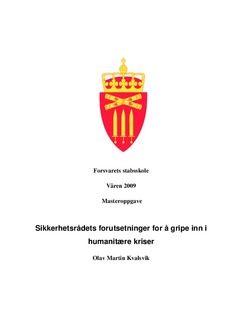| dc.description.abstract | The UN Members confer on the Security Council ‘primary responsibility for the maintenance of international peace and security’. According to the UN Charter Chapter VII, Article 39, the Council shall determine the existence of any threat to the peace, breach of the peace or acts of aggression, and shall make recommendations, or decide what measures shall be taken, to maintain or restore international peace and security. These measures may include the use of armed force. This paper examines key considerations the Security Council must take when authorizing the use of armed force to prevent massive violations of international human rights. I will do this under the four headings; 1) the Councils´ legal mandate; 2) the political context; 3) the ‘humanitarian impulse’ in international relations and; 4) the issue of Security Council reform. The purpose is not to draw unambiguous conclusions but to contribute to the debate on the role of the Council as a collective instrument when humanitarian crises arise within a sovereign state | en_US |
